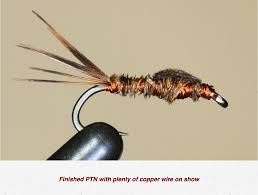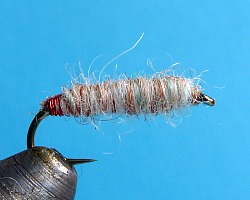Shaun is the instructor and offered these notes.
Original Sawyer’s Pheasant Tail Nymph.

It’s such a common fly now that its easy to take for granted, but the original is quite different from what you might pick up from your local fly shop, and has a history that’s worth understanding.
Frank Sawyer was the inventor of this fly. No flashback, no peacock here, just a simple fly that he used to catch trout for a living on the River Avon the 1920s as a keeper. There are several Avon’s in England, this was the one near Salisbury/Stonehenge. It’s my favourite river name and Avon in proto Celtic means river, so it’s clear what the waterway is!
The Sawyer nymph is just small or extra small copper wire (gold, silver and red also work), and several long pheasant tail fibres – not even any thread is required. It’s so simple that I left out the materials list because it looked embarrassingly short! Add a nymph hook of your preference and you are all set.
The tying instructions are also pretty straightforward. Rather than write out a very short list, perhaps it’s best to see Frank himself tie it for us. This is the only footage of him tying recorded:
His Killer Bug

Out of guilt for the simplicity of the nymph, I’m going to show a second on the night – His Killer Bug. Originally a Grayling fly, but trout don’t seem to be so sophisticated as to care. Again the tying list is three items long, same hook, same wire, and a pinkish, brownish or greenish hank of wool. There’s a whole mythology behind what wool to use, and I have a collection of the ‘right’ ones if anyone wants to drop in and collect a sample, but again, I suspect the trout don’t spend enough time in knitting stores to really care.
keyword wetfly nymphfly
